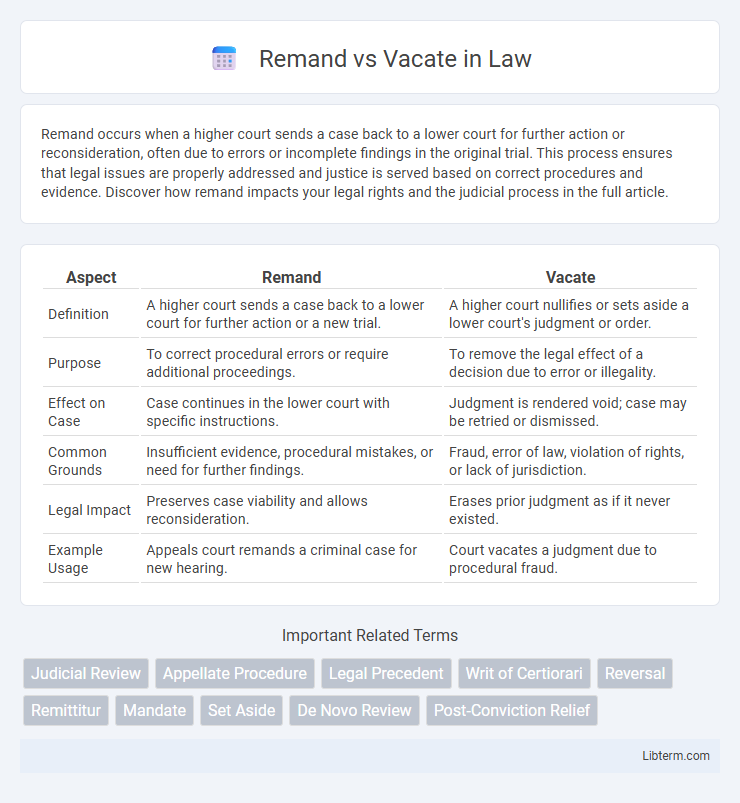Remand occurs when a higher court sends a case back to a lower court for further action or reconsideration, often due to errors or incomplete findings in the original trial. This process ensures that legal issues are properly addressed and justice is served based on correct procedures and evidence. Discover how remand impacts your legal rights and the judicial process in the full article.
Table of Comparison
| Aspect | Remand | Vacate |
|---|---|---|
| Definition | A higher court sends a case back to a lower court for further action or a new trial. | A higher court nullifies or sets aside a lower court's judgment or order. |
| Purpose | To correct procedural errors or require additional proceedings. | To remove the legal effect of a decision due to error or illegality. |
| Effect on Case | Case continues in the lower court with specific instructions. | Judgment is rendered void; case may be retried or dismissed. |
| Common Grounds | Insufficient evidence, procedural mistakes, or need for further findings. | Fraud, error of law, violation of rights, or lack of jurisdiction. |
| Legal Impact | Preserves case viability and allows reconsideration. | Erases prior judgment as if it never existed. |
| Example Usage | Appeals court remands a criminal case for new hearing. | Court vacates a judgment due to procedural fraud. |
Introduction to Remand and Vacate
Remand refers to a court sending a case back to a lower court for further action or reconsideration based on identified legal errors or issues. Vacate means a higher court nullifies or sets aside a previous court decision, effectively erasing its legal effect. Both remanding and vacating alter the status of judicial rulings but serve distinct procedural purposes in appellate review.
Definition of Remand
Remand is a judicial process where an appellate court sends a case back to a lower court for further action consistent with the appellate court's ruling. This procedure allows the lower court to reconsider or correct its decision based on legal errors identified on appeal. Remanding ensures proper application of the law and provides an opportunity to address issues without overturning the entire case.
Definition of Vacate
Vacate means a higher court nullifies or overturns a lower court's decision, effectively erasing the previous ruling without sending the case back for further action. This legal action removes the binding effect of the prior judgment, leaving the matter as if the decision had never been made. Vacating a decision often occurs when significant legal errors or procedural issues undermine the validity of the original ruling.
Key Differences Between Remand and Vacate
Remand refers to a higher court sending a case back to a lower court for further action or a new trial, while vacate means the higher court nullifies or sets aside the lower court's judgment or order. A remand typically preserves the lower court's decision for reconsideration or amendment, whereas vacating eliminates the legal effect of the original ruling entirely. The primary difference lies in remand requiring additional proceedings, whereas vacatur voids the decision, often due to errors or procedural issues.
Legal Grounds for Remand
Remand occurs when an appellate court sends a case back to the lower court for further action or reconsideration due to identified legal errors, insufficient evidence, or procedural issues. The legal grounds for remand typically include errors in the application of law, improper admission or exclusion of evidence, or failure to follow statutory or constitutional requirements. Vacate, by contrast, entirely nullifies a lower court's judgment or order without necessarily directing further proceedings.
Legal Grounds for Vacate
Legal grounds for vacating a court decision typically include errors of law, lack of jurisdiction, procedural irregularities, or newly discovered evidence that could significantly affect the outcome. Courts may also vacate judgments if the decision was based on fraud, misrepresentation, or if enforcing the judgment would result in a miscarriage of justice. Vacating differs from remanding, as vacating nullifies the original decision, removing its legal effect.
Remand Process in Court
The remand process in court involves a higher court sending a case back to a lower court for further action or reconsideration, often due to legal errors or insufficient facts in the original ruling. During a remand, the lower court is required to follow the appellate court's instructions, which may include conducting a new trial, re-evaluating evidence, or applying the correct legal standards. This process ensures that the case is resolved accurately while preserving judicial oversight and adherence to proper legal procedures.
Vacate Process in Court
Vacating a court decision involves nullifying or setting aside a previous judgment, effectively erasing the original ruling and restoring the case to its prior state. The vacate process typically requires a party to file a motion demonstrating grounds such as procedural errors, newly discovered evidence, or fraud that justify invalidating the judgment. Upon approval, the court treats the case as if the original decision never occurred, allowing for reconsideration or a new trial.
Impact of Remand and Vacate on Case Outcomes
Remanding a case sends it back to a lower court for further action, often leading to additional fact-finding or reconsideration aligned with appellate guidance, which can result in modified or new rulings. Vacating a judgment nullifies the prior decision, effectively erasing its legal effect and often requiring the case to be retried or reexamined without the influence of the vacated judgment. The impact of remand typically involves refining legal or factual determinations, whereas vacating alters case outcomes by removing precedent and legal finality, affecting future litigation and judicial consistency.
Frequently Asked Questions About Remand vs Vacate
Remand and vacate are legal terms often associated with appellate court decisions. Courts frequently remand cases to lower courts for further proceedings or to correct errors, while vacating refers to nullifying or setting aside a previous judgment. Common questions include the differences in their legal effects, reasons for remand versus vacate, and their implications for ongoing litigation.
Remand Infographic

 libterm.com
libterm.com